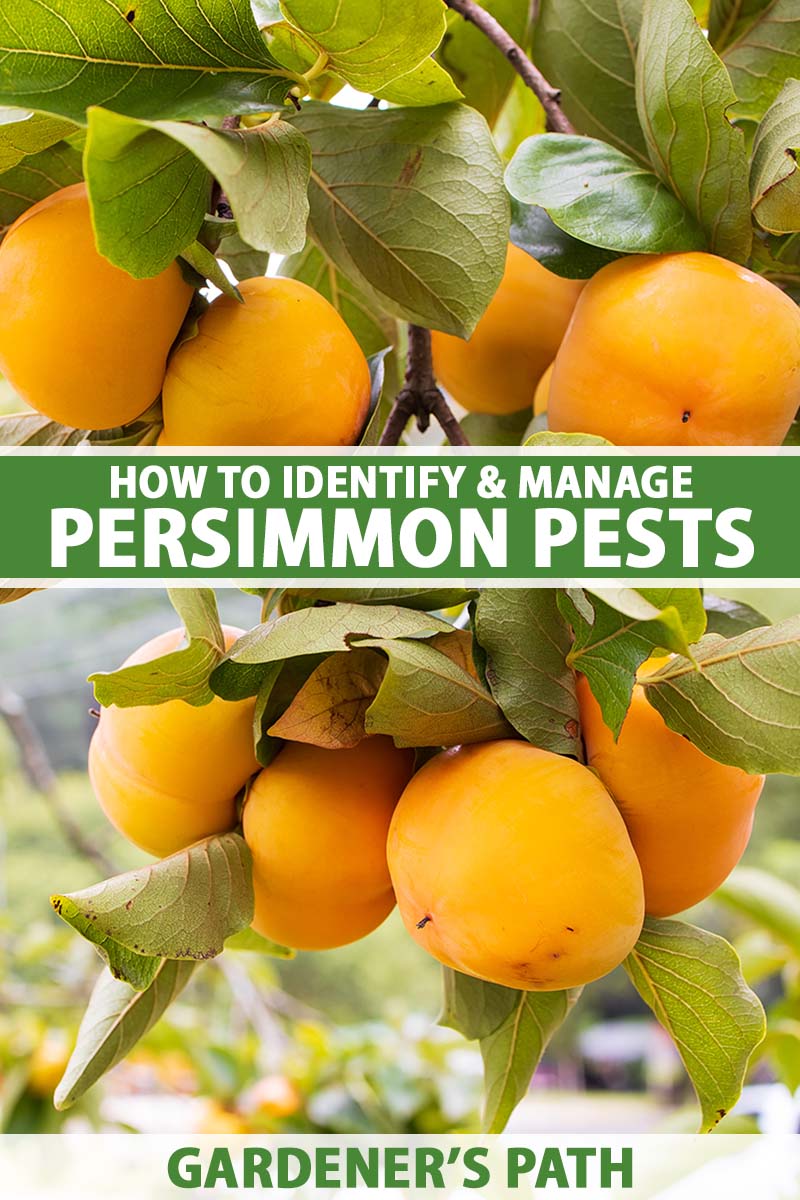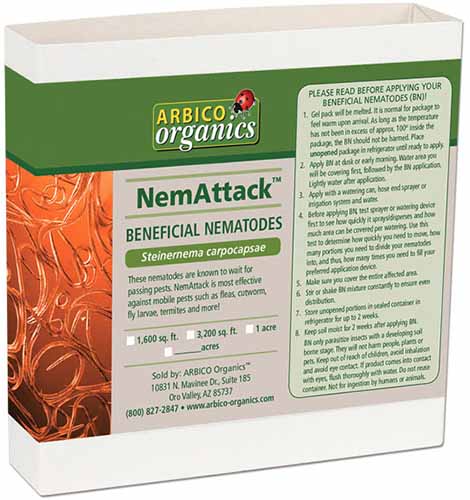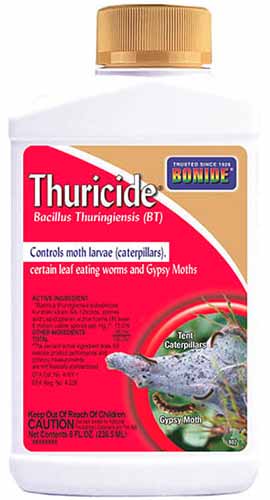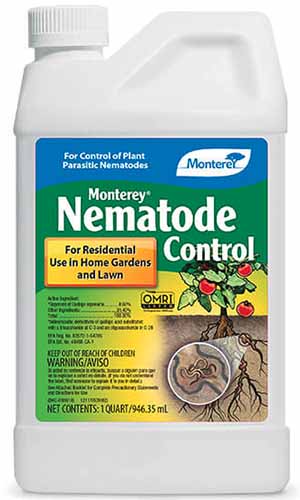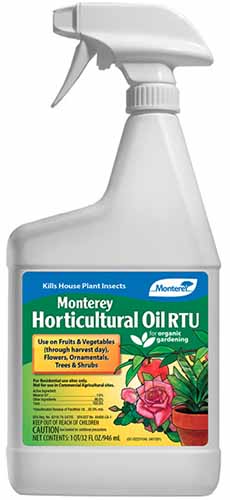Persimmons are magical. I’m especially fond of the American species, Diospyros virginiana, because the fruit is so incredibly sweet and flavorful.
They’re also impossible to find in stores because the fruits don’t store or travel well at all, so unless you’re lucky enough to live near a grower who is willing to share, you have to grow your own.
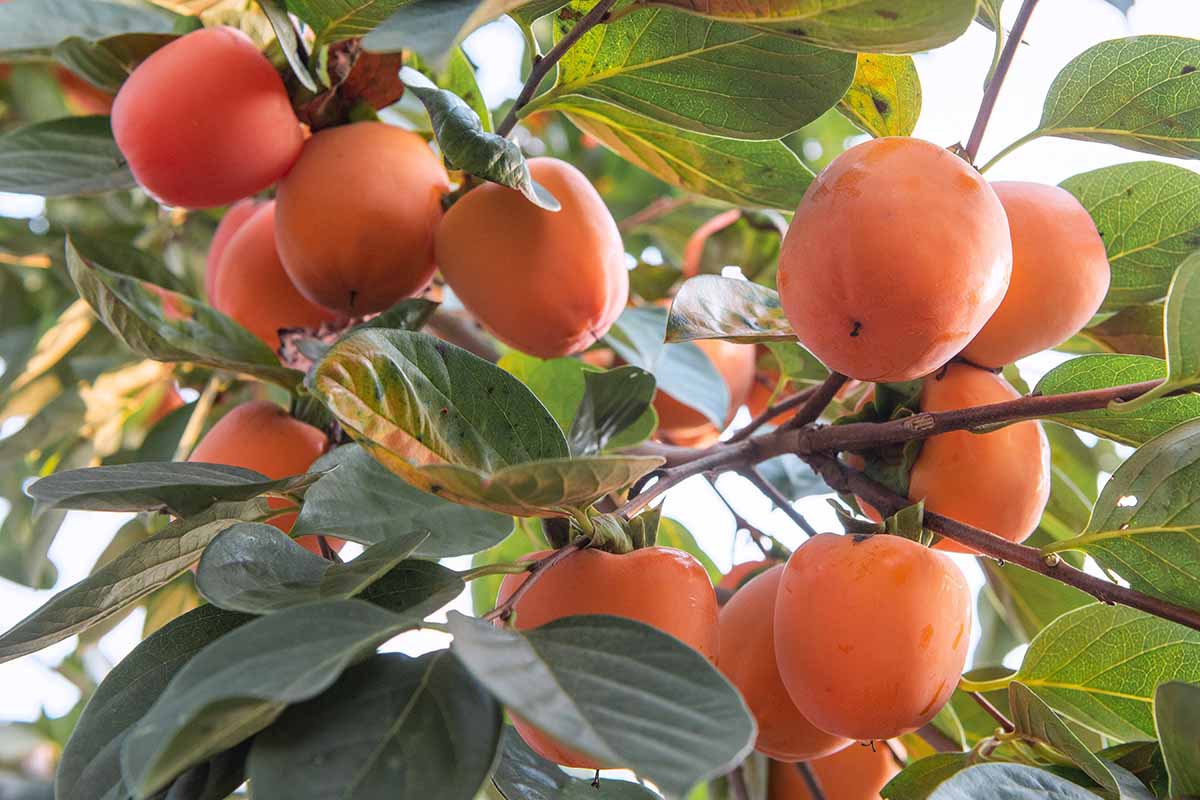
We link to vendors to help you find relevant products. If you buy from one of our links, we may earn a commission.
Growing persimmons comes with its own set of challenges, including the neverending battle against garden pests.
The good news is that persimmons aren’t often troubled by pests, unless you count birds and other herbivores who want to share in the bounty. But that doesn’t mean you can let your guard down.
In our guide to growing persimmons, we cover how to cultivate these trees in your landscape.
And to keep your plants healthy and thriving, we’re going to go over the 15 common persimmon pests to watch out for. Here’s the list:
15 Common Persimmon Pests
American persimmons tend to be more frequented by pests in North America than the Asian species, Diospyros kaki, primarily because both the trees and the pests that visit them evolved together in the same region.

That doesn’t mean American persimmons are weaker or more prone to problems. While they’re visited more often, they’re generally untroubled by an attack and will rebound on their own pretty quickly.
Pests that target Asian persimmons tend to be less common but more damaging.
1. Ambrosia Beetles
I wish we were talking about the musical Beatles, but alas. It’s the persimmon pest kind we need to address.
Ambrosia beetles from the Curculionidae (weevil) family can be serious pests of persimmons, particularly American species, though they aren’t wildly common.
The invasive granulate ambrosia beetle (Xylosandrus crassiusculus), black stem borer (X. germanus), and camphor shot borer (Cnestus mutilatus) are the three most damaging.
The pests drill through the bark and cambium layer and inoculate the persimmon tree with pathogenic fungi, which they feed on. The beetles are attracted to the scent of ethanol that trees release when they are stressed.
Look for the strands of frass or sawdust – these are known as toothpicks – that the beetles kick out of the holes as they drill. Once the beetles enter the tree, it will start to wilt and branches will die.
We’re not exactly sure what mechanism causes the tree death, but that’s the next step in the beetle invasion. It may be the damage to the persimmon tree’s vascular system caused by the beetles or the fungi overwhelming the plant. Either way, the tree dies.
Unfortunately, once a tree is infested, the only option is to remove it and burn the wood.
Keeping the tree healthy and caring for it with the appropriate water, fertilizer, light exposure, and pruning will help to prevent the persimmon becoming stressed and attracting the beetles in the first place.
2. Birds
I almost hesitate to list birds as pests since a healthy persimmon tree can produce more than enough fruit for all of us to enjoy.
Birds have also evolved in the same area along with the native persimmon fruit trees, so they rely on them as a food source.
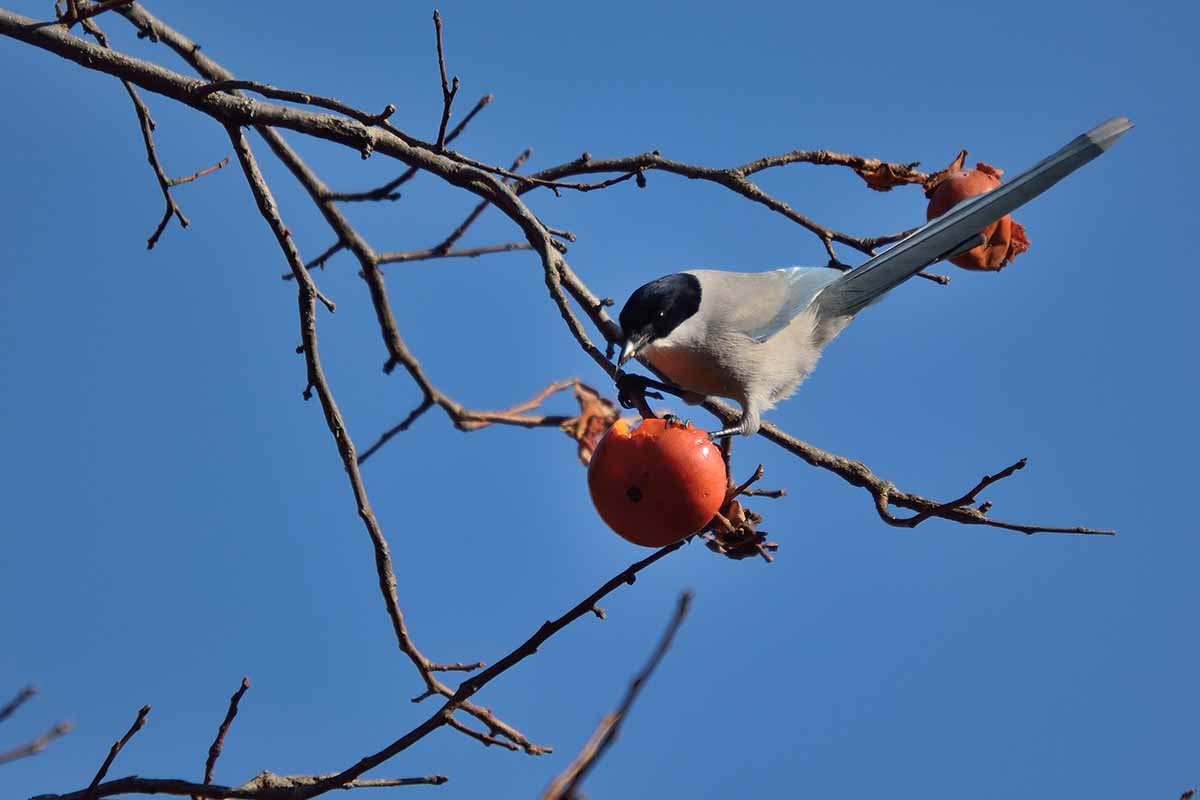
That said, if you don’t want to share your persimmons, then birds can be a real challenge. This is especially true of fruit from the American species, which become softer and easier to eat while still on the tree.
Once the fruits are ripe, the birds start going to town. I find they prefer the persimmons at the top of the tree and generally leave the lower fruits alone unless they’ve eaten all the higher ones. Don’t worry, squirrels will take care of the lower persimmons.
Birds may make off with entire fruits or – more commonly – simply leave them on the tree and peck at them, rendering those fruits inedible.
Your options are to either place a net over your persimmon tree to keep the birds out or just let nature take its course.
Look for bird safe netting, if using, so you don’t inadvertently trap and kill your avian visitors.
Safe netting is either extremely fine so they can’t get their legs or wings wrapped up in the mesh or somewhat rigid so it doesn’t twist and trap the birds.

I personally prefer something like this bird netting, available via Amazon, which includes zippers and a drawstring to fully enclose the tree.
It protects the fruits from birds as well as keeping squirrels and rodents at bay as well.
3. Borers
Persimmon clearwing borers (Sannina uroceriformis) infest native species.
They don’t feed on Asian persimmons, but those trees grafted on American rootstock are susceptible. The adult moths are found along the eastern part of the US from Texas to as far North as New Jersey.
The adults are black or blue-black with orange bands and clear wings. They look a bit more like wasps than moths.
The females lay their eggs at the base or in the bark and when the larvae hatch, they tunnel through the cambium and into the roots and the wood.
Since all their tunneling and hard work goes on where we can’t see it, it can be a real challenge to figure out whether your persimmon tree’s decline is caused by borers or something else.
You might see black gum emerging from the bottom of the trunk, along with the general decline of the plant. If your tree seems to be stunted, wilted, or otherwise less than robust, dig down and examine the roots. Tunneled roots will collapse or you might be able to see the holes.
The larvae can also girdle and kill roots, so look for dead roots.
We know that rodents will snack on the larvae, but other than letting rats and voles have their way with your orchard, beneficial nematodes, specifically Steinernema carpocapsae, are going to be the best way to address an infestation.
NemAttack Beneficial Nematodes
The first step is to grab a pack of the beneficial nematodes from Arbico Organics in the spring, and apply according to the directions on the package, as soon as the ground has reached 42°F in your area.
Do a second application a month later. The reason it’s advisable to do two applications is that most of the nematodes will die after a month unless they have something to eat and we can’t know exactly when the larvae will be most active, so we’re covering our bases here.
4. Caterpillars
Caterpillars are generally more of a problem for American persimmons than Asian ones, but both types may be affected.
Redhumped caterpillars (Schizura concinna) are kind of pretty, with yellow, orange, black, and white bodies and a red end.
The grayish-brown adult moths are kind of bland, it’s the larvae that eat the leaves of the persimmon tree and the ends of the branches. They don’t feed on fruits.
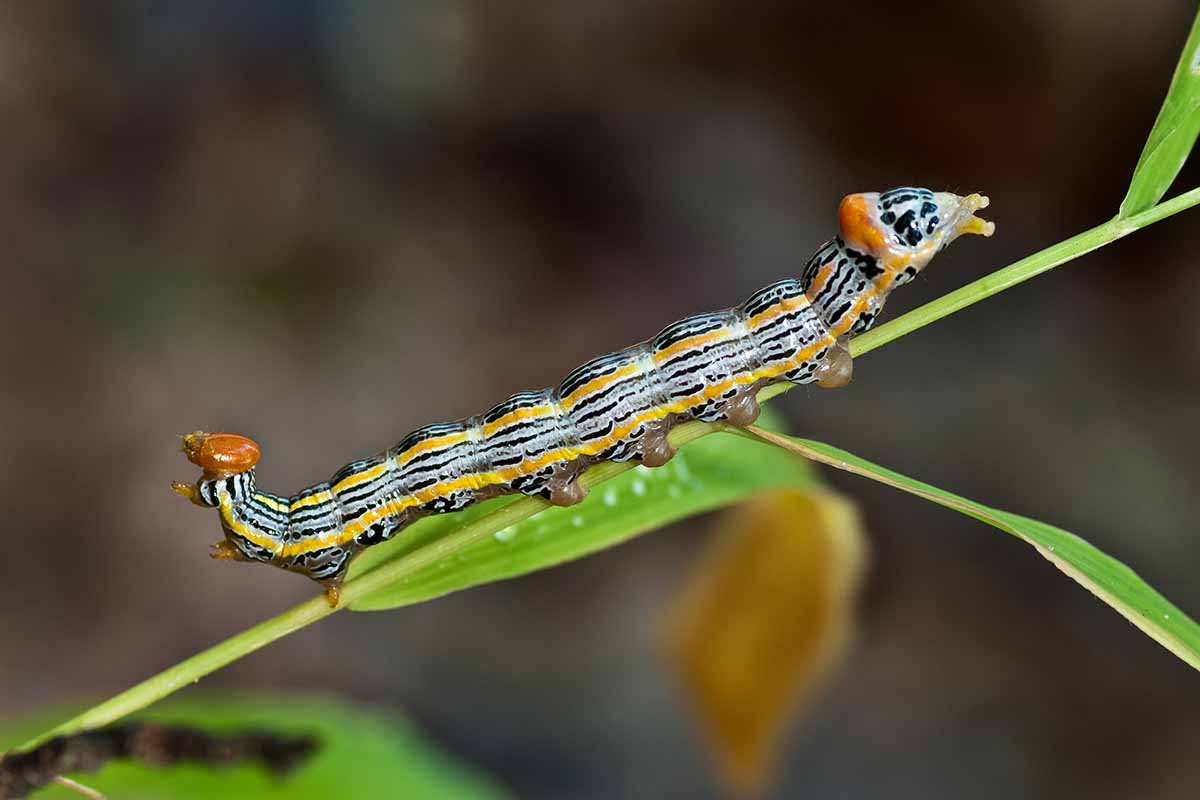
Oblique-banded leafrollers (Choristoneura rosaceana) are native to North America. The larvae are medium green, and the adult moths are tan with brown splotches.
These caterpillars are voracious. In large enough numbers, they can eat enough leaves that fruit production is severely reduced.
Variable oakleaf (Lochmaeus manteo, syn. Heterocampa manteo) caterpillars are green or pinkish with a brown or reddish dorsal band on their backs.
The head is green with a cream border. They generally occur in large numbers every few years, with few seen during the in-between years.
For that reason, even though they can devour the leaves of the persimmon tree when they are present in large numbers, they don’t cause long-term damage. You might have a reduced harvest during the years of heavy infestation, but the tree will recover during normal years.
The hickory horned devil (Citheronia regalis) is pretty cool looking. They have yellow, black, and cream banding on a green body and orange-red legs. They also have a crown of spiky reddish-orange horns.
Don’t worry about the detailed description. They’re the largest caterpillars in the US and can grow over five inches long and feed on the leaves of the tree.
So if you see a caterpillar with horns that is big enough to be mistaken for a snake, you can be confident you’re looking at a hickory horned devil.
The adult moths are a beautiful gray-green with yellow and orange banding and cream spots. They can have a wingspan of up to six-inches wide.
All of these caterpillars are native to North America and all of them are an important part of the ecosystem.
Unless you have a young persimmon tree that is being completely defoliated year after year, you really don’t need to do much. Let the birds and other natural predators eat them as you hum “The Circle of Life” to yourself.
If you’re worried about the health of the persimmon tree because it’s being defoliated year after year, hand-pick the caterpillars (wear gloves in case you’re sensitive) or prune off heavily infested branches. Bacillus thuringiensis v. kurstaki (Btk) is also an effective treatment.
You can find several products out there that contain this beneficial bacteria. Once the caterpillars eat it, they stop feeding and die.
Bonide Thuricide is one such product and it’s available at Arbico Organics as ready-to-use or concentrate.
5. Citrus Nematodes
Citrus nematodes (Tylenchulus semipenetrans) are soilborne parasitic roundworms that feed on more than just plants in the citrus family.
They also love persimmons, particularly the Asian species.
These pests are extremely common and can be found in a majority of citrus orchards, so if you have any of those nearby or you’re growing your persimmons where citrus trees used to grow, it’s highly likely they’re around.
The female larvae tunnel their heads into the roots and feed, which causes girdling. When a root is girdled, it can’t take up nutrients and water, causing the tree to slowly decline.
The leaves and fruits might be smaller than usual, some of the leaves might turn yellow, and entire twigs might die.
This also stresses the tree and leaves it vulnerable to other problems. A healthy tree can withstand some drought but a stressed one might die, for example.
There are treatments available that you can use, but you will need to do so repeatedly and it will likely take several years before the tree recovers.
Products that contain saponins can help control parasitic nematodes by limiting egg development.
For example, Monterey Nematode Control has saponins derived from the soapbark tree, Quillaja saponaria.
Since this product doesn’t work on adult populations, you have to keep at it to kill each generation of eggs.
Grab a quart at Arbico Organics and apply to the soil every 14 days from spring through fall.
6. Deer
Persimmons are known as “deer candy” as ungulates adore them. They love the fruits so much that hunters actually use a product made from persimmons to attract deer.
So you’d better believe that if you have deer in your area, they will discover your persimmon tree at some point.

Most of the time, it’s not a huge problem because they’ll typically go for the fallen fruits.
But deer can be a nuisance because they will eat the young twigs and leaves, as well as any low-hanging fruit.
You can either fence off the young persimmon tree or fence your entire garden if you’re determined to protect the plants.
Learn more about how to deter deer in our guide.
7. Fuller Rose Beetles
Fuller rose beetles or weevils (Naupactus godmanni or N. cervinus) are known for devouring roses, but they will also eat persimmons of both types, as well as stone fruits, apples, strawberries, and all caneberries.
The adults lay their eggs in the soil and after hatching the larvae feed on the plant’s roots.
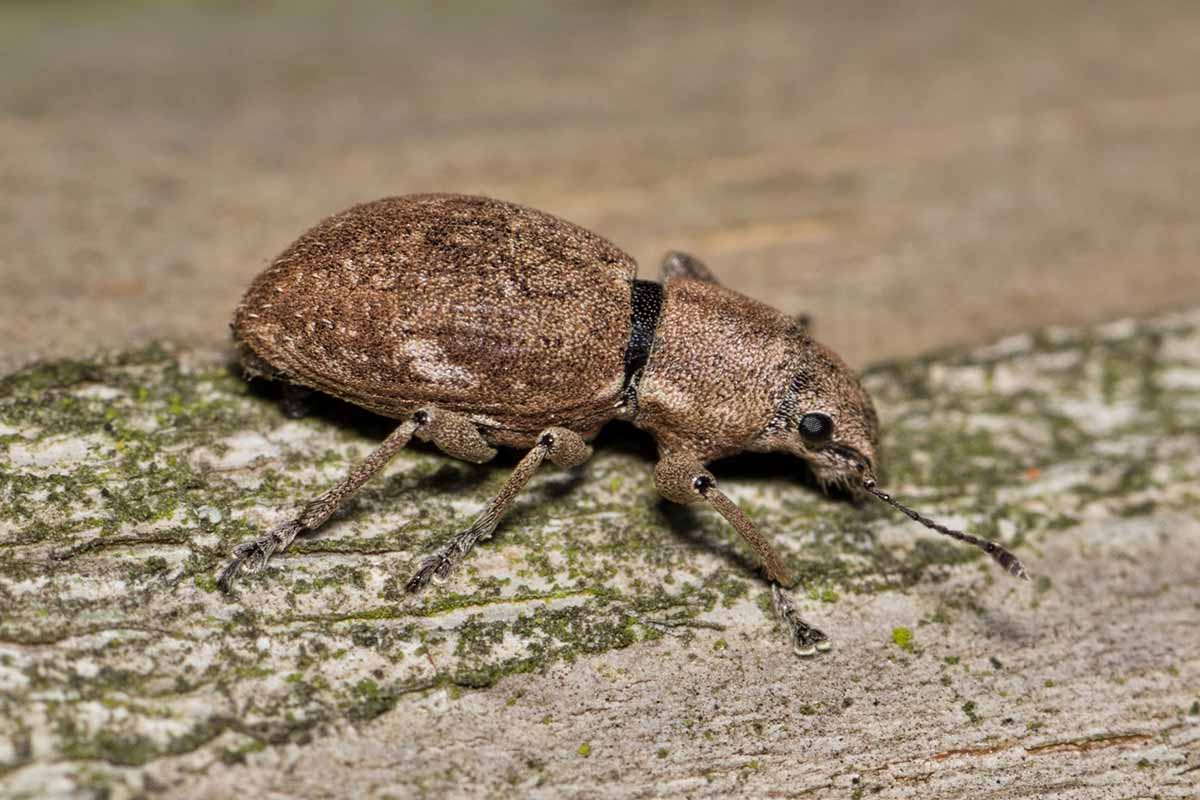
This feeding does the most damage to the persimmon tree, but the adults continue the damage as they nibble on the edges of the leaves.
It’s ugly but it doesn’t do nearly as much damage as the root feeding unless you have young trees that are heavily infested.
The root and leaf damage can also leave the plant vulnerable to disease.
This invasive beetle reached the US in 1879 and has spread from its landing site in California across the US. It’s currently found in at least 30 states coast to coast.
The adults create telltale jagged edges on the margins of the persimmon leaves.
If you see that type of damage, look for the beetles, which are grayish-brown with curved brown snouts. They like to hang out where the twigs meet, near leaf buds, or even on the ground.
If you don’t see the adults, try holding white paper under a branch and give it a good shake. If present, the pests will fall off the tree onto the paper.
They start emerging from the ground in the summer and that’s when you want to treat the trees, with the goal of killing the adults so they can’t lay eggs and start a new generation that will trouble your trees next year.
Natural predators like endoparasitic wasps, the Asian citrus psyllid (Diaphorina citri), assassin bugs from the Reduviidae family, birds, and spiders all eat the beetles and larvae.
You should prune your persimmon trees so that no branches hang within 24 inches of the ground. The beetles can use these to climb into the canopy.
Remove any suckers, as well. Then, place a sticky trap around the circumference of the trunk about two feet up.
This might be enough to control a minor infestation, though it might take two or three years.
If you want to deal with a bad infestation, grab a product that contains bifenthrin and apply it according to the directions once in July and again in August.

You can pick up Talak’s 7.9 percent bifenthrin concentrate in gallon jugs at Amazon.
8. Gall Mites
Eriophyid mites are microscopic pests that aren’t visible to the naked eye, but you’ll know they’re around when your persimmon tree starts to form swollen galls on the branches and trunk.
In persimmons, it’s the persimmon bud mite (Aceria diospyri) that causes the damage.
These pests attack all Asian types, and when they do, you’ll find large galls and defoliation of the young shoots.
An infestation will also cause fruit to turn black and fall from the tree. We call the blackening of the fruit “rust” as it starts out looking like rusty brown streaks and patches.
It’s not the same as the fungal rust that you’ll find on your daylilies and veggies in the summer, though.
Some cultivars are more susceptible to damage from the mite than others, with ‘Fuyu’ and ‘Tonewase’ being generally asymptomatic.
The mites reproduce in dormant buds and emerge in the early spring to feed on the leaves. Once the fruits start to develop, the mites move into the calyxes. That’s the part where the leaf-like growths sit on top of the fruit.
The best way to control this pest is to spray when the mites have moved into the leaves.
Since you can’t just pop a leaf open and look for the little invaders, you’ll need to make an educated guess and repeat the treatment several times during the growing season.
Sulfur is highly effective and relatively benign in the garden. Combined with permethrin, it works to eliminate these pests.
You can find sulfur available at Arbico Organics in one-pound bottles or four-pound bags.

Then, pop over to Amazon to pick up a 10 percent permethrin solution from Durvet in an eight-ounce container.
Starting a few weeks after the leaves have fully opened in the spring, spray the persimmon tree with permethrin. Then, a few days later, spray with sulfur. Two weeks later, do the same again.
Try to spray on a day when there isn’t a breeze, preferably when it’s cloudy and there aren’t many pollinators out to try to avoid harming beneficial insects.
9. Mealybugs
There are many species of mealybugs out there, and several of them think persimmons of both types make a fantastic meal.
The comstock (Pseudococcus comstocki) Gill’s (Ferrisia gilli), longtailed (P. longispinus), and grape (P. maritimus) mealybugs are the four most common.
Gill’s is the most prevalent species in California orchards, where many commercial persimmons come from.
All of these are oval creatures with a white, waxy protective coating. If you look closely, you can usually see little white antennae and legs.
The problem with identifying these pests is that they don’t move much and they cluster in groups. They also hang out under leaves or calyxes, or at nodes, so you’re likely to miss them. If you do see them, you might think your tree has a fungal problem.
But if you gently scrape them off, it becomes more obvious that you’re facing a mealybug infestation and not some white fungal infection.
Beyond draining the sap from the tree using their sap-sucking appendages, they also transmit diseases.
Mealybugs can damage the persimmon fruits as they feed and cause yellowing foliage.
They also cause fruit drop, and they excrete a sticky substance called honeydew, which attracts sooty mold. This mold reduces photosynthesis and tree vigor.
Only the males fly and there usually aren’t many of them, so these pests rely on you to forget to clean your tools and equipment, and to fail to quarantine new plants before bringing them into your yard.
There are lots of predators out there who would love the chance to help you with your mealybug problem.
Green lacewings (Mallada signata), mealybug destroyers (Cryptolaemus montrouzieri) and predatory flies are just salivating at the idea of a tasty all-you-can-eat mealybug buffet.
Some predators will find their way into your garden on their own, but you can also purchase beneficial insects like lacewings at Arbico Organics and introduce them.
They can be purchased in quantities of 400, 1,000, 5,000, or 10,000, depending on the area you need to cover.
You can also use insecticides if you’re thoughtful about it. Our guide to mealybugs explains all the details.
10. Psyllids
Persimmon psyllids (Baeoalitriozus diospyri or Trioza diospyri) cause similar damage to that of aphids. They use their sucking mouthparts to draw sap out of the plant of both Asian and American persimmons.
As they feed, these insects inject toxic saliva which can cause curled, puckered, and distorted leaves. The nymphs also secrete a white, mildew-like substance that results in the development of galls on the leaf buds.

On top of that, psyllids secrete sticky honeydew which attracts sooty mold. And they can also spread diseases.
Hot weather and natural predators like parasitic wasps usually keep populations in check, but cool weather and overuse of pesticides in the garden can cause an unhealthy increase in psyllid numbers.
The best way to control them is to do your usual prune in the fall or winter and then apply dormant oil in the early spring.
The oil will smother the eggs, larvae, and nymphs and suppress populations enough that they shouldn’t cause serious damage to your trees.
Visit Arbico Organics and pick up some Monterey Horticultural Oil in a variety of ready-to-use sizes and as concentrate.
Spray once in the early spring as the buds are developing and then again three weeks later. That should do the trick.
11. Rodents
Just as they attract deer, persimmons also attract rodents. And I don’t mean that a mouse, squirrel, or rat will take a nibble if they happen to pass by a persimmon tree.
Nope, they will go out of their way to find and devour the fruit.
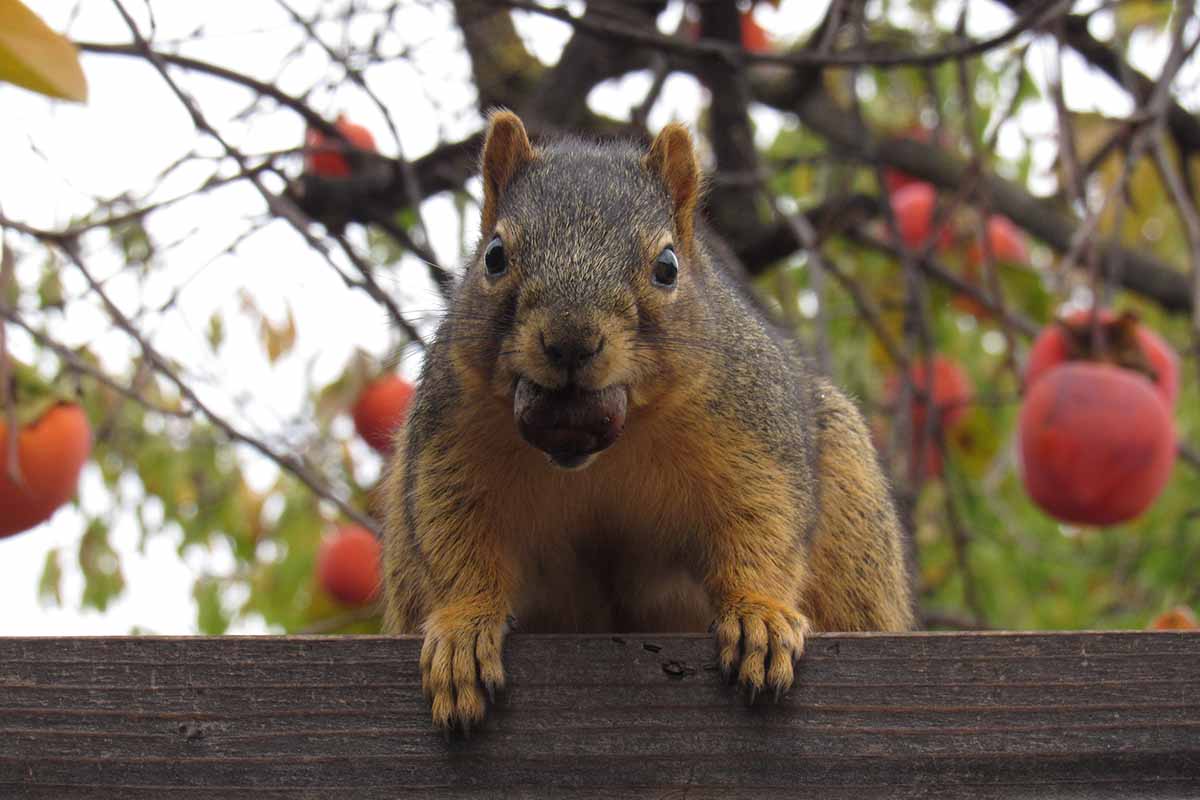
When the fruits are ripening, be diligent about your preferred method of rodent control, whether that’s trapping, poisons, or exclusion.
I like netting, but sometimes that isn’t even enough. Have you ever seen a determined squirrel work on a tree?
Most of the time, I just share the bounty. There’s plenty to go around, but make sure to harvest as soon as the persimmons are ripe.
Don’t leave them on the tree or they’re sure to become a meal for marauding rodents.
12. Root-Knot Nematodes
Root-knot nematodes are parasitic nematodes in the Meloidogyne genus. They’re similar to citrus nematodes in that they feed on the roots causing swellings, knots, and galls on the roots of the trees.
These knots reduce the amount of water that the tree can take up and also open it up to root rot and infection via soilborne pathogens.
Aboveground, the plants will usually look sad, with wilting, dry, yellowing leaves, chlorosis, and stunted growth.
Root-knot nematodes are less common than citrus nematodes, but that doesn’t mean you can completely ignore them.
If you suspect an infestation, dig down and examine the roots of your persimmon tree. You can also send a soil sample to your local extension office.
Then, read our guide to learn how to treat root-knot nematodes. The process is similar to treating citrus nematodes.
While you’re at it, plant some marigolds around your trees. These ornamental favorites have been proven to deter and kill these microscopic parasites.
13. Scale
Scale insects are pretty common on all persimmon trees, but an infestation doesn’t usually cause many issues.
There are number of species that feed on persimmons, including greedy (Hemiberlesia rapax), lecanium (Parthenolecanium corni), and tuliptree scale (Liriodendron tulipifera).
Most of us gardeners don’t realize that our plants have a problem until we discover the sticky honeydew they leave behind or maybe some yellowing, wilting foliage.
The insects themselves are oval and somewhat flat, plus they cluster in groups and don’t move much. As a result, they can look like symptoms of a disease or funky lumps instead of the pest problem they actually are.
Much of the time, you don’t need to treat them, but young or weak trees might be negatively impacted. You can learn more about how to deal with scale in our guide.
14. Twig Girdlers
Twig girdlers (Oncideres cingulata) are aptly named. I remember the first time I saw their work. I truly thought someone had taken pruners to my persimmon tree without my knowledge.
In the case of a large infestation, you might see a lot of severed twigs on the ground underneath the tree. If you examine the ends, it looks like a tiny beaver has been at work.
Twig girdlers feed on pecan, hickory, elm, poplar, dogwood, oak, and just about every fruit tree, including persimmons, typically the American types.
The girdling certainly ruins the appearance of the tree, but beyond that, it cuts off fruits or the wood that will grow fruits in the future.
It also causes strange branching and leaves the tree vulnerable to diseases. The pests can also girdle young trees, killing them.
The adults, which are half-inch-long beetles with horns, feed in the summer and then lay eggs in the cuts they make in the stems and branches. The larvae overwinter there before pupating and emerging as adults in midsummer.
If you see a bunch of twigs under your tree and you don’t recall doing any pruning, it’s probably twig girdlers.
Make sure to rake up all the fallen debris and dispose of it. This is the best method of control. They are native insects and an important food source, and they won’t generally kill a tree.
So, raking up the leaves and twigs to interrupt their life cycle is usually enough to keep an infestation to manageable numbers.
15. Webworms
Fall webworms (Hyphantria cunea) look much scarier than they actually are.
The adult moths are unremarkable, but the larval stage tends to freak people out as they weave large nests out of webbing.
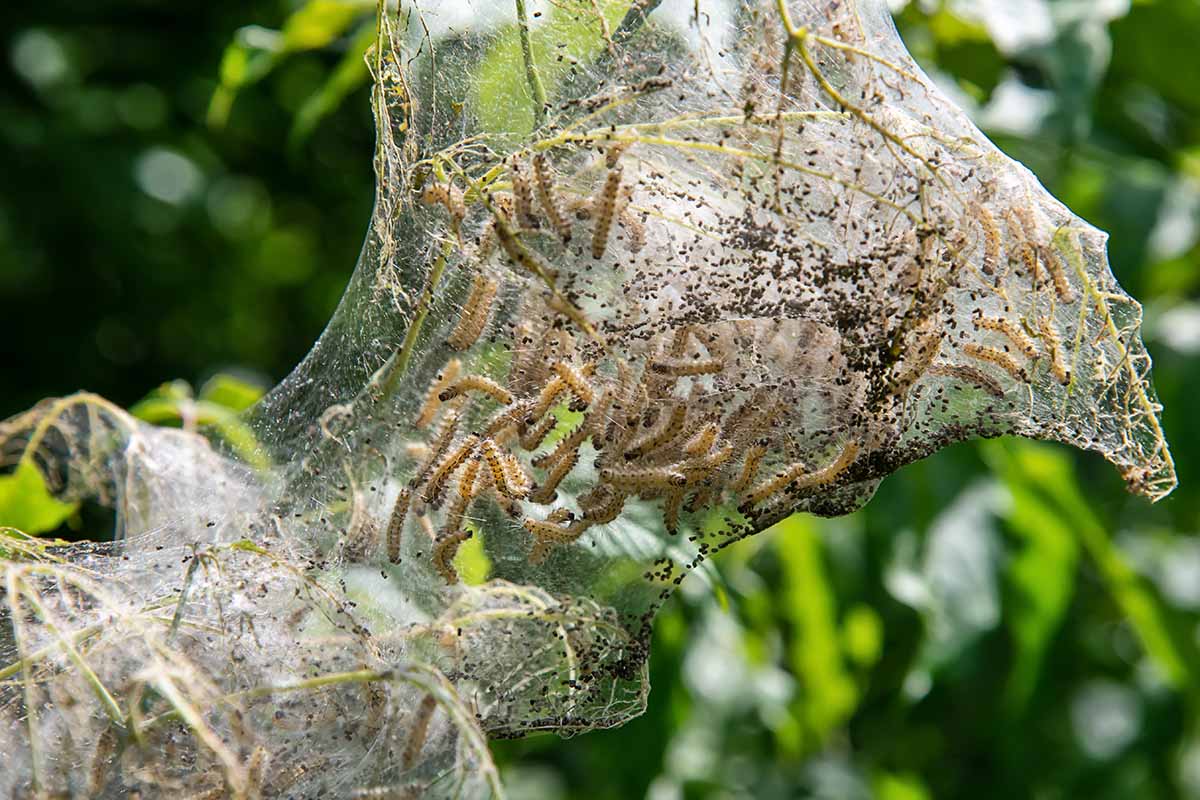
Webworms don’t harm the tree, though, so you can safely ignore them.
They will eat the leaves and sometimes can even defoliate a tree, but it will bounce back with maybe nothing more than a slightly reduced harvest.
You Can Hardly Blame Pests for Loving Persimmons
Whenever I see deer, squirrels, or birds devouring the fruits of my labor, I can’t feel too bad about it. Persimmons are incredibly delicious and I’d be doing the same thing if I were a bird.
And even though this list of persimmon pests is long, you can rest easy knowing that though there are a number that can visit your tree, they don’t all make frequent appearances.
Which critter do you suspect you’re dealing with? Do you need any further help diagnosing the issue? Let us know if we can lend a hand in the comments section below.
Care to explore more of the big, beautiful world of persimmons? We’ve got you covered! Here are a few other topics to check out next:
